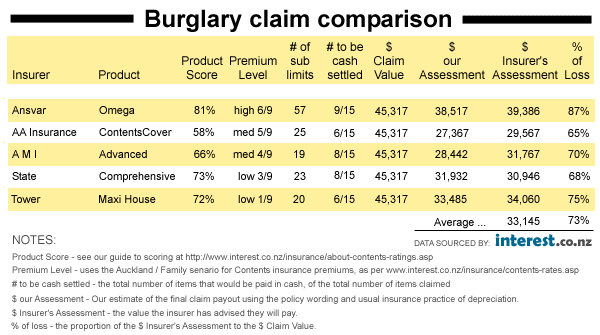
By John Grant
When you take out insurance and pay a premium, the policy will compensate you if you incur a loss. We’ve put this to the test with five companies and the results are quite revealing.
We asked them to assess what they would pay for a burglary loss involving 15 items with a replacement value of $45,317. The list of items taken in the burglary can be seen in this link here >> The proposed settlement amount from these companies ranged from $29,567 to $39,386. The average payment was just 73% of the $45,317 claim, or $33,145. The main cause of the reduced payouts was due to policy sub-limits that apply in Contents insurance.
The results 
Insurers surveyed
We selected five insurers for this review. Ansvar was chosen for this comparison as it rated the highest in our policy comparisons. The other insurers were selected as they represent the major players in the ‘direct’ insurance market.
Product scores
You can go here to see our contents policy scoring results. Ansvar’s Omega policy scored 82% and not surprisingly has come in with the highest payout figure amongst the five insurers. The policy scoring is a comprehensive benchmarking of products available in New Zealand. To see more information on how we score the policies, you can follow this link.
Premium levels
Ansvar appear to have a clear intent of providing one of the best covers in the market place, but it comes at a cost and they were the sixth most expensive company of those we researched. You can go here to see Contents premium comparisons. Ansvar are also the most expensive of the five companies included in this review. Their Contents premium for $120,000 of cover was $683.38. The least expensive was Tower at $327.82. (For this review, we used a specific policy coverage for a property in Browns Bay on the North Shore of Auckland.) This clearly illustrates a correlation between price and policy coverage. Tower on the premium comparison and the claim scenario provide good value. Ansvar provide the best, but it is also most expensive.
Number of sub limits
The claim involved the loss of some very expensive items. It would be fair to say that a claim like this may not be ‘normal’ or 'average', but it is quite realistic. It also highlights the importance of policy sub-limits. It is common for sub-limit issues to have a part to play in claim settlements. Sub-limits can be seen as an index of complexity.
But sub-limits are not necessarily a negative. It could well reflect additional cover that has been added to a policy that others may not have, and has therefore been capped by the placement of a maximum claim amount. It is therefore more about the dollar maximums in the sub-limits. Interestingly, Ansvar has around 57 sub-limits in their policy, the most of anyone surveyed. The more there are, the more complex the policy is to administer and understand. Therefore it makes it very important that you are aware of these sub-limits and what possessions you may have that could be subject to a maximum payment amount limit.
In nearly every case an insurer will agree to a request to raise the limit. This will require a valuation and it will attract an additional premium for each item specified. AA Insurance, AMI and State Insurance all revealed lower payout amounts for our 'burglary'. Each of these insurers have low policy limits and in this particular claim this was particularly influential in reducing what they would pay.
AA Insurance went to a great deal of trouble to research each item and strongly promoted a philosophy of working closely with a claimant to attempt to make the claim process less stressful. Wherever possible they will replace items taken. Suzanne Wolton, a spokesperson for AA Insurance said that it would be unusual for a claim of this nature to occur, as they discuss policy limits with customers at the time insurance is taken out. And they remind customers at renewal of the need to specify items and to review the policy limits.
State Insurance adopt a similar approach and their spokeperson, Lesley Acutt said, “Our customer has just experienced a very stressful event and we want to make the process as simple as possible. Once they have phoned in to tell us of the event, our team will work closely with them to build a report on the circumstances of the loss. A State Loss Adjuster will be assigned to the customer to assist in the identification of the items that have been taken. “The Loss Adjuster will assist the customer to complete a Loss Schedule and look at any documentation supporting the claim. They will make enquiries and get current values of the goods so that we can replace items of the same specifications.”
Mike Clapp from Tower said that a customer of this nature would probably be recommended their top end product, Super Maxi which has much higher limits on unspecified items. If they had settled a claim under that other policy then this payout amount would have been considerably higher. The minimum sum insured for that Super Maxi product is $200,000 and is focused on the top end of the market.
Replacement or cash settlement
We have endeavoured to illustrate how claims on various items are settled. In nearly every case an insurer will prefer to settle a loss by replacing an item. This is usually done by the way of a voucher to be taken to a supplier to be exchanged for goods similar to the ones stolen. This is popular amongst insurers for a couple of reasons;
- Replacing items fulfils the policy replacement conditions. If you are given an identical item to replace the one that has been taken then insurance has fully met the obligations to meet the loss.
- It minimises the potential for fraud. In some cases fraud has been detected with claims and has a higher potential in cases where people want cash for items.
- Insurers have negotiated discounts from suppliers. Therefore they can reduce the cost of the claim. The customer gets a lost or damaged item replaced and the insurer pays a discounted price. It was good to see that some insurers will in some cases pass this discount onto their customers. AA Insurance will do so where items are subject to policy sub-limits.
Some of the items in this loss were included to see how insurers would react to a situation where the customer did not want to replace items that would normally be settled by replacement vouchers. This is dealt with by the wording in several policies. The method of settlement is normally the prerogative of the insurer. But if a customer wants to cash as the settlement then some of the policies cater for this by clearly stating the payment will be reduced by 50%. The Tower Maxi Protection policy says “If you choose not to replace or repair we will pay the present day value up to a maximum of 50% of the item’s replacement value”. The present day value is defined as the depreciated value. Similar wordings appear in most of the policies, however AMI will pay the equivalent of the net cost to them to replace the item (after supplier discounts) and AA Insurance said “If our customer didn’t want to replace the jewellery or watch specifically they could choose to have a store credit with one of our suppliers, which means they can choose whatever they would like, instead of replacing all the individual items. Most customers do this. However, in the minority of cases where a customer only wants to have a cash settlement, we would pay them the same as we would have paid the store.” Discounts for insurers can be quite significant. They can range from just a minor reduction to discounts of over 25%.
Our assessment of the claim
In each case we looked closely at the insurers policy wording, and did an informed estimate on what we thought they would pay. Although we are not claims assessors the results were surprisingly close to what the insurer reported. It was interesting to see some differences though. Nearly all of the differences were in the area of the depreciation applied. This is where items are being settled for market or indemnity value due to policy conditions.
Each policy is different in what replacement conditions are applicable and you can see more about this on the policy comparison pages. Normally a depreciation rate is determined by looking at the life expectancy of an item and how far through its life cycle it is at the time of the loss or damage. A formal dress for example could last for years and will therefore depreciate at a slower rate than an item of everyday wear. It was also interesting to see that AMI would settle the full amount of the cosmetics lost at its replacement price irrespective of the fact that 50% had been consumed. This practice was not adopted by other insurers.
The Insurer’s assessment
Each of the insurers reviewed the claim as if it was a customer of long standing who was able to show clear proof of ownership. They all said that the process is one of individual negotiation with a customer and staff will do what they can to help finalise the claim.
How to make sure you don’t end up in a similar situation
With the number of limitations in policies, it would not be surprising if most people would have an item or two in their home that would be caught by these policy caps. Therefore the first step is to read the policy and understand what sub-limits apply in your policy. It worth making a list of these sub-limits, and the current replacement price of the items you own in these categories. If you are not sure of the value then do some research. Sites like 'Trademe' and Google searches are a good way of working out a ball-park figure. If the replacement value of an item is close to the policy sub-limit, then get a valuation. Jewellery valuations are quite easy to obtain and are not overly expensive. Camera and watch valuations are also quite easy to get; just go to a specialist shop and they will normally provide this at little or no cost. When you have these consider whether you would want replacement or a cash payout. Once you have all this detail then contact your insurer and make arrangements for the policy to be extended as you need it. Like all insurance matters, it does take 'work' - without that effort, you are likely to feel unhappy when you have a claim.
You can see our detailed assessment of each of the insurers we surveyed here ...
- Ansvar
- AA Insurance
- A M I
- State
- Tower

We welcome your comments below. If you are not already registered, please register to comment
Remember we welcome robust, respectful and insightful debate. We don't welcome abusive or defamatory comments and will de-register those repeatedly making such comments. Our current comment policy is here.